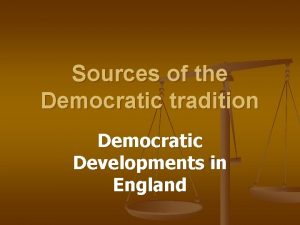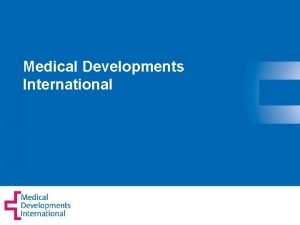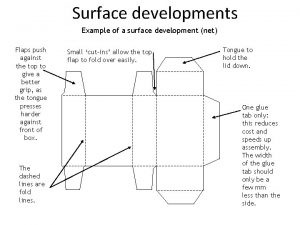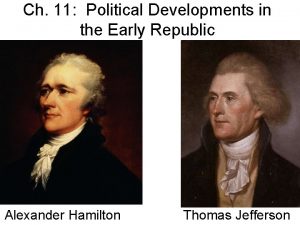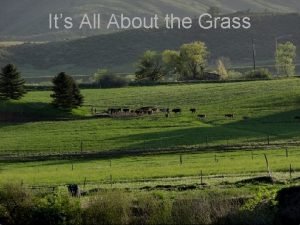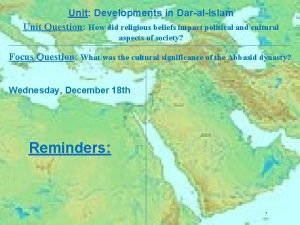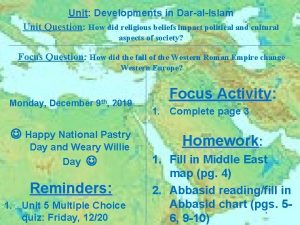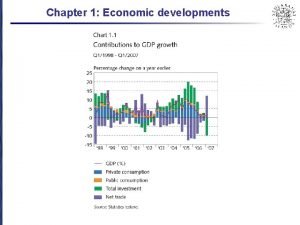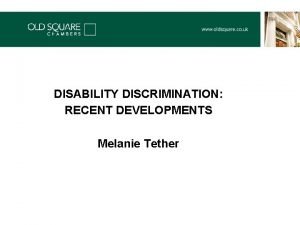1 2 Developments in DaralIslam 1 2 Developments










- Slides: 10

1. 2 Developments in Dar-al-Islam

1. 2 Developments in Dar-al-Islam • Essential Question: In the period from c. 1200 to c. 1450, how did Islamic states arise, and how did major religious systems shape society? • Big Picture: • Three major religions – Judaism, Christianity, and Islam continued to influence culture in Europe, Africa, and the Middle East. • Islam spread rapidly in the centuries after the death of Muhammad (570 -632). • Military actions • Merchants • Missionaries

1. 2 Developments in Dar-al-Islam • Big Picture: • • Advances in algebra Medicine Libraries Schools Poetry Art Architecture • Abbasid Caliphate • Baghdad, House of Wisdom • Center of Learning • Christians and Muslims cooperate

Islam spreads over the Arabian Peninsula • Before Mohammad’s death, he united the Arabian Peninsula • Encouraged to spread Islam with the expansion of trade routes, and some military conquest • In the area of rule, not forced to convert, but had to pay a tax for not being Muslim, called the Jizya • Egalitarian nature of the religion attracted many new converts

Islam in Practice • All muslims need to follow the 5 pillars • Concept of Jihad, or inner struggle to strive in the way of Allah to improve both oneself and society. Interpreted differently by some today • Islamic code of law is called Shariah Law, outlines behavioral requirements for daily life. Like no drinking alcohol or eating pork, but Polygamy is permitted up to 4 wives.

The first four Caliphs and Umayyads • The succession over who should lead Islam and become the Caliphs led to a split in the Muslim World • Sunnis: Believe that the best qualified should lead • Shia: Believe that only a blood dependent of the prophet is able to lead • The Term Dar al-Islam, refers to the Islamic world

More on the Caliphs and Umayyads • Caliphs spread Islam beyond the peninsula • Later, capable generals founded the Umayyad Dynasty and spread Islam to it’s height and moved the capital to Damascus • Shia beliefs resisted and their community leader became knows as imam rather than caliph

Abbasid Caliphate • Came to power in 750 C. E. and moved the capital to Baghdad which soon rivaled Constantinople in both wealth and population • Baghdad became the center of learning, made thicker, more useful paper, Baghdad represented the golden age of learning • Also here they created the first ideas of hospitals for people, and studied the human body

Comparing Islamic Empires Umayyad Empire BOTH 661 -750 C. E. • Location: Southwest Asia, North Africa, and Southwest Europe • Capital: Damascus and then Cordoba Abbasid Empire 8 th-13 th Century • BRANCH OF ISLAM: SUNNI • ETHNICITY OF LEADERS: ARAB • FOREIGN POLICY: SPREAD INFLUENCE OF ISLAM • Location: Southwest Asia and North Africa • Capital Baghdad

INVASIONS AND TRADE SHIFTS • 1100’s and 1200’s the Abbasid Empire suffered from attacks from four different outside groups • Mamluks (West): Took control of Egypt and recruited slaves known as Mamluks to serve as soldiers and government officials. Most were Turkish. They established an empire across North Africa • Seljuk Turks (North): took over the Middle East, including Baghdad, and leader took the title of sultan. This reduced the role of the highestranking caliph. • Crusaders: Seljuk Turks limited the access of Christians to Jerusalem so the Pope called for the Crusades to open back up the city and holy sites • Mongols: Conquered what was left of the Abbasid empire in 1258 and pushed the Seljuk Turks out of Baghdad. They continued to push westward and were stopped in Egypt by the Mamluks.
 Democratic developments in england
Democratic developments in england Mdi medical devices international
Mdi medical devices international Netflaps
Netflaps Recent developments in ict
Recent developments in ict Definition patterns of development
Definition patterns of development Political developments in the early republic
Political developments in the early republic American grassfed association standards
American grassfed association standards Transmission developments
Transmission developments Recent developments in object detection
Recent developments in object detection The development of an object that is rolled or folded
The development of an object that is rolled or folded Cplim
Cplim
